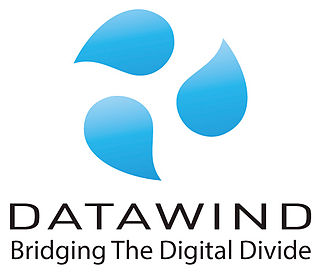Mobile blogging (also known as moblogging [1] ) is a method of publishing to a website or blog from a mobile phone or other handheld device. A moblog helps habitual bloggers to post write-ups directly from their phones even when on the move. [2] Mobile blogging has been made possible by technological convergence, as bloggers have been able to write, record and upload different media all from a single, mobile device. At the height of its growth in 2006, mobile blogging experienced 70,000 blog creations a day and 29,100 blog posts an hour. [3] Between 2006 and 2010, blogging among teens declined from 28% to 14%, while blogging among adults over 30 increased from 7% to 11%. [4] However, the growing number of multi-platform blogging apps has increased mobile blogging popularity in recent years creating a brand new market that many celebrities, regular bloggers and specialists are utilizing to widen their social reach. [5]
Mobile blogging is popular among people with camera phones which allow them to e-mail/MMS or SMS photos and video that then appear as entries on a web site, or to use mobile browsers to publish content directly to any blogging platform with Mobile Posting compatibility. [6] [7] As the ability of camera phone users to publish their own blogs has increased, so too has the ability for collective submissions. Users are now able to access the posts of other bloggers in the immediate area through a process called Georeferential Blogging; which utilizes geographical location to collectively group blogging activity. [8] This advancement unites the posts of local bloggers in an effort to increase the relevancy of information to those in the area.
One of the precursors to a "moblog" was the development of a wearable photographic device by Steve Mann of the University of Toronto. Termed "domewear," the intention was for human rights workers to wear the devices to take photographic and video evidence of dangerous situations while avoiding being targeted for using traditional cameras. [9] The first recorded example of moblogging was on 1995 February 22, when Steve Mann posted text from his wearable mobile computer to his weblog server, together with video (image sequence). [10] The term moblogging, however, wasn't coined until 2002, by Adam Greenfield. [1] Mobile devices have expanded beyond basic communication and now these devices can support multimedia creation tools. [11]
The mobile blogging system has its origins in a technology-inspired design approach. This approach incorporates the rich feature set of a smartphone, including the ability to create multimedia, capturing decent images, and connectivity options. The intersection between the inherent design functions of the phone with the ongoing, personal nature of both a phone and a blog is how the concept of mobile blogging began. In the case study of SmartBlog, a system created to support mobile blogging, key principles were developed after assessing bloggers' needs. [11] These include:
The client, in this instance, refers to a Thin client. [11]
A moblog platform offers the capability to use a phone for administration, editing and writing from a phone or smartphone browser. There are services and platforms which present different versions of a blog administration interface based on user agent.
Mobile blogging also promotes the dissemination of ideas and perspectives of younger people, who previously have not had as many easily accessible platforms to present their views. [12]
The continued integration of Mobile Blogging into areas of education has revealed many of its advantages. Its benefits affect both students and teachers, and have improved the overall educational experience. For students, it allows them to stay up-to-date with class schedules, access materials, and it inspires a more creative dimension with the inclusion of visual and audible materials in their work environment. [13]
For teachers, mobile blogging has allowed further monitoring of students’ progress and participation. [13]
Mobile blogging can be used alongside computer-supported collaborative learning in the classroom. This provides a positive and encouraging learning environment for students, especially students in a virtual classroom. Working collaboratively with mobile blogging can provide more authentic context learning and can help solve the coordination issue that often arises from working in a collaborative learning environment. [14]
Mobile blogging is particularly helpful to tourists and travelers when access to a computer with Internet connection may be difficult. The traveller can snap photos and with a GPRS or a WAP-enabled phone can easily upload such pictures with text descriptions directly to his or her blog. If the camera phone is equipped for Autogeotagging, the blog may be able to show a map of the locations.
One of the most significant challenges to mobile blogging is lack of access to both mobile devices and internet connections. While mobile blogging encourages production and spread of information to seemingly limitless people, it must be understood in regards to the advantages and disadvantages of socioeconomic status and geographical location. [12]
One of the most substantial and relevant challenges to having a mobile blogging network is the costs involved. Western countries face relatively cheap costs in terms of data plans and expenditures related to mobile devices, yet in most places around the world, these costs are very substantial and restrictive. When the costs are too high, mobile blogging and its benefits become irrelevant. [13]

A smartphone is a mobile device that combines the functionality of a traditional mobile phone with advanced computing capabilities. It typically has a touchscreen interface, allowing users to access a wide range of applications and services, such as web browsing, email, and social media, as well as multimedia playback and streaming. Smartphones have built-in cameras, GPS navigation, and support for various communication methods, including voice calls, text messaging, and internet-based messaging apps.

A mobile device or handheld computer is a computer small enough to hold and operate in the hand. Mobile devices are typically battery-powered and possess a flat-panel display and one or more built-in input devices, such as a touchscreen or keypad. Modern mobile devices often place emphasis on wireless networking, to both the Internet and to other devices in their vicinity, such as headsets or in-car entertainment systems, via Wi-Fi, Bluetooth, cellular networks, or near-field communication.
Windows Mobile is a discontinued mobile operating system developed by Microsoft for smartphones and personal digital assistants.
A vlog, also known as a video blog or video log, is a form of blog for which the medium is video. Vlog entries often combine embedded video with supporting text, images, and other metadata. Entries can be recorded in one take or cut into multiple parts. Unlike a more general video diary, vlogs are often recorded depicting the maker throughout.
M-learning, or mobile learning, is a form of distance education where learners use portable devices such as mobile phones to learn anywhere and anytime. The portability that mobile devices provide allows for learning anywhere, hence the term "mobile" in "mobile learning." M-learning devices include computers, MP3 players, mobile phones, and tablets. M-learning can be an important part of informal learning.
This is a list of blogging terms. Blogging, like any hobby, has developed something of a specialized vocabulary. The following is an attempt to explain a few of the more common phrases and words, including etymologies when not obvious.
Mobile VoIP or simply mVoIP is an extension of mobility to a voice over IP network. Two types of communication are generally supported: cordless telephones using DECT or PCS protocols for short range or campus communications where all base stations are linked into the same LAN, and wider area communications using 3G or 4G protocols.
An edublog is a blog created for educational purposes. Edublogs archive and support student and teacher learning by facilitating reflection, questioning by self and others, collaboration and by providing contexts for engaging in higher-order thinking. Edublogs proliferated when blogging architecture became more simplified and teachers perceived the instructional potential of blogs as an online resource. The use of blogs has become popular in education institutions including public schools and colleges. Blogs can be useful tools for sharing information and tips among co-workers, providing information for students, or keeping in contact with parents. Common examples include blogs written by or for teachers, blogs maintained for the purpose of classroom instruction, or blogs written about educational policy. Educators who blog are sometimes called edubloggers.

The Nokia N95 is a mobile phone produced by Nokia as part of their Nseries line of portable devices. Announced in September 2006, it was released to the market in March 2007. The N95 ran S60 3rd Edition, on Symbian OS v9.2. It has a two-way sliding mechanism, which can be used to access either media playback buttons or a numeric keypad. It was first released in silver and later on in black, with limited edition quantities in gold and purple. The launch price of the N95 was around €550.
The Nokia 6000 series or Classic Business series is range of mobile phones marketed by Nokia. This family of phones is notable for their conservative, unisex designs, making them popular with business users.
The Nokia 7650 is a 2.5G consumer-oriented mobile phone belonging to the fashion and experimental (7xxx) series. It was introduced in Barcelona on 19 November 2001, and was described by CEO Jorma Ollila as the company's most important launch of that year.
Mobile-assisted language learning (MALL) is language learning that is assisted or enhanced through the use of a handheld mobile device.
A Mobile Web Server is software designed for modern-day smartphones to host personal web servers through the use of open sourced software.
Novarra was a mobile internet software company founded in 2000 and based in Itasca, Illinois, United States. It created web-based services such as web internet access, portals, videos, widgets and advertising for mobile devices. Novarra provided access to the internet and other services through wireless handsets, PDAs and laptops and sold directly to operators, mobile handset manufacturers and internet brand companies. In 2010, Nokia acquired 100% of Novarra's shares.

Mobile technology is the technology used for cellular communication. Mobile technology has evolved rapidly over the past few years. Since the start of this millennium, a standard mobile device has gone from being no more than a simple two-way pager to being a mobile phone, GPS navigation device, an embedded web browser and instant messaging client, and a handheld gaming console. Many experts believe that the future of computer technology rests in mobile computing with wireless networking. Mobile computing by way of tablet computers is becoming more popular. Tablets are available on the 3G and 4G networks.
Mobile journalism is a form of multimedia newsgathering and storytelling that enables journalists to document, edit and share news using small, network connected devices like smartphones.
Nokia's strategic nomenclature can be traced back in 2005 when the Nseries line was launched, offering devices with flagship specifications and premium hardware at various price points. These devices were considered the "bread and butter" of the company and were often positioned to showcase their latest technologies. Thanks to the newfound consumer and enterprise interest in smartphones at the time, the company introduced four additional collections to diversify their product portfolio and meet demands in most market segments. These new phone series were named Eseries, targeting small business and enterprise customers; Xseries, providing consumer-grade multimedia-focused devices; Cseries, which Nokia used to target both the low-end and mid-range market segments; and Tseries, for devices exclusive to the Chinese market.

Jeotex, Inc. was a Canadian company that developed and manufactured low-cost tablet computers and smartphones. Founded in Montreal, Quebec, the company aimed to produce tablets primarily for markets in India, Nigeria, the United Kingdom, Canada, and the United States. Joetex created the Aakash tablet computer, which was called the "world's cheapest tablet" as it was priced at US$37.99 per unit in 2012. The Aakash was developed for India's Ministry for Human Resource Development (MHRD).

ChatON was a global mobile communication service provided by Samsung Electronics from September 2011 to March 2015.